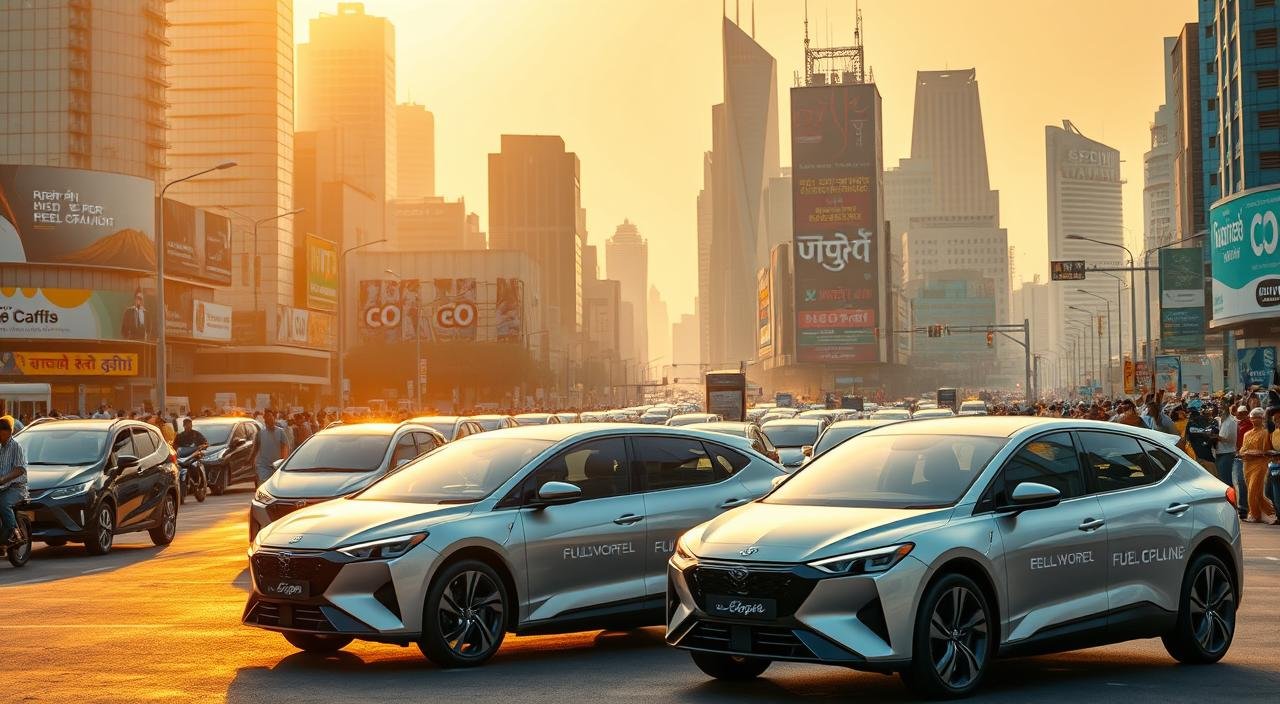
Oct
The Indian car market is on the verge of a big change. The government has announced a 5% GST rate for fuel-cell cars, starting September 22, 2025. This move puts hydrogen vehicles on the same level as petrol and diesel cars, changing the game.
Five key fuel-cell vehicles are set to hit the Indian market. Thanks to the lower GST rate, these cars will be more affordable for people looking for green options. This is a big win for those wanting to switch from traditional engines.
Now is the perfect time for this change. Global car makers are adding more fuel-cell models to their lines. With the 5% GST, fuel-cell cars in India can compete with traditional cars on price. This move shows India’s dedication to hydrogen technology in the car industry.
Key Takeaways
- India reduces GST on fuel-cell vehicles to 5%, matching rates for petrol and diesel cars
- Five hydrogen vehicles are prime candidates to launch in India following the tax benefit
- The policy takes effect September 22, 2025, making FCVs more affordable for buyers
- Fuel-cell cars now enjoy equal tax treatment with conventional vehicles for the first time
- Major automakers are preparing to introduce hydrogen models to capitalize on the incentive
- The GST reduction could accelerate India’s shift toward zero-emission transportation
Understanding Fuel-Cell Technology
Fuel-cell technology is a big step forward in cars, making them cleaner and more efficient. In India, people are looking for better ways to travel than old gas engines. FCVs are a top choice because they use hydrogen to make electricity, leading the way in green cars.
What Are Fuel-Cell Vehicles (FCVs)?
FCVs run on hydrogen fuel cells, making electricity from hydrogen and oxygen. They don’t burn gas like regular cars, so they only make water vapor and heat. This means no big batteries are needed, unlike electric cars.
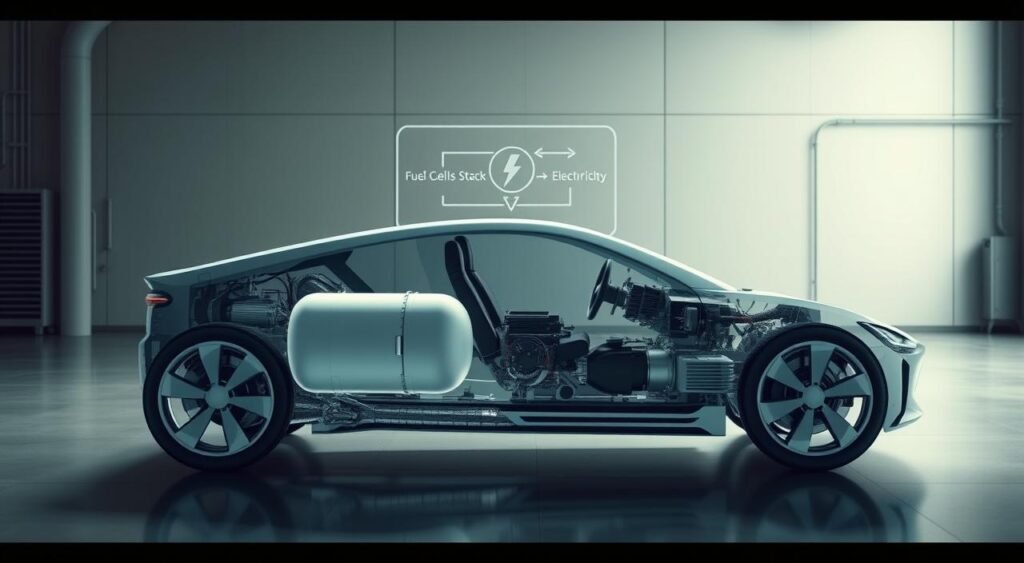
How Do Fuel Cells Work?
Fuel cells work by breaking down hydrogen into protons and electrons. The electrons make electricity for the car’s motor. Oxygen and the protons make water vapor, the only thing these cars emit.
Key Benefits of Fuel-Cell Technology
Hydrogen cars have many good points:
- Rapid refueling: Fill up in just 3-5 minutes, like gas cars
- Extended range: Go 400-600 kilometers on one tank
- Zero emissions: Only make water vapor
- Energy efficiency: Use 60% of fuel energy for power
- Quiet operation: Make very little noise
| Feature | FCVs | Traditional Vehicles |
|---|---|---|
| Refueling Time | 3-5 minutes | 5-7 minutes |
| Emissions | Water vapor only | CO2, NOx, particulates |
| Energy Efficiency | 60% | 20-35% |
| Range per Tank | 400-600 km | 500-800 km |
The Current State of Fuel-Cell Cars in India
The Indian car market is changing, moving from old engines to new, cleaner ones. Electric cars are getting popular, but fuel-cell cars are also gaining attention. The car industry in India, worth over $100 billion, is looking into hydrogen cars as a green option.
Overview of the Indian Automobile Market
India has a huge car market, with over 3.8 million cars sold every year. Big names like Toyota, Hyundai, and Tata Motors lead the market. Toyota, for example, has 12 models, but no fuel-cell cars yet.
People are starting to want cleaner cars because of pollution and bad air in cities. This interest could help fuel-cell cars become more common in India.
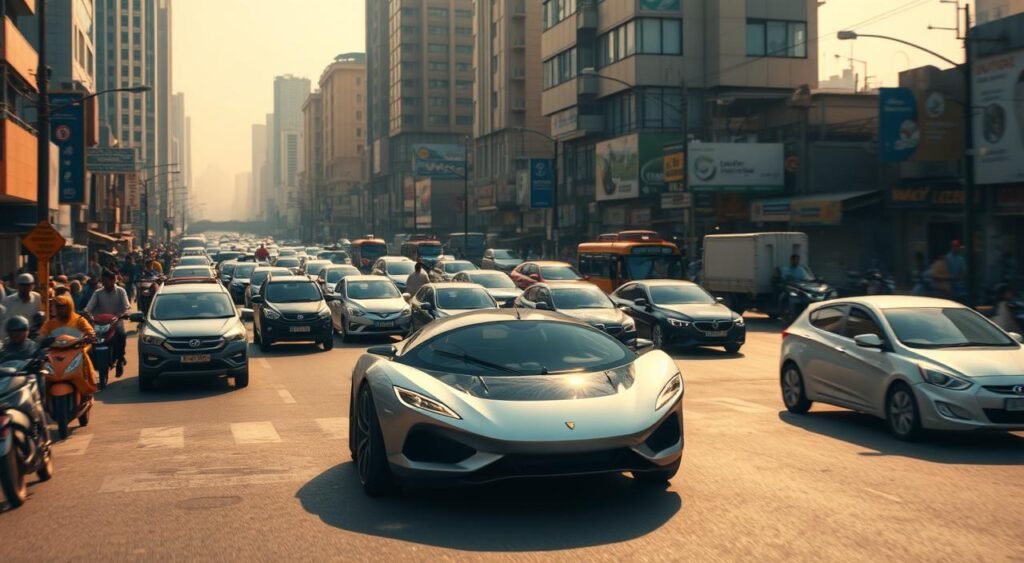
Government Policies Supporting FCVs
The government is backing hydrogen cars with new rules. They want to make fuel-cell cars cheaper to buy. In 2022, the government started a program with Toyota to test hydrogen cars.
Some key policies include:
- A new plan to make more green hydrogen
- Help for companies making fuel-cell cars
- Money for building hydrogen stations
- Tests in some cities to see how well they work
Challenges Facing FCV Adoption in India
Fuel-cell cars in India face big challenges. The biggest one is the lack of places to fill up with hydrogen. Hydrogen stations need special equipment and safety measures.
Other problems are the high cost of these cars, not many people know about them, and electric cars are also popular. The car industry, government, and others need to work together to make hydrogen cars a reality in India.
Financial Implications of GST on Fuel-Cell Vehicles
The introduction of a 5% GST rate for fuel-cell vehicles is a big deal for India’s car market. This lower tax makes these eco-friendly cars more affordable than regular cars. It means buyers can get advanced hydrogen technology at a better price.
What is GST and How Does It Work?
Goods and Services Tax (GST) is India’s single tax system that replaced old taxes. For cars, GST rates change based on the car’s type and features. Most cars face a GST rate between 18% and 28%, with extra taxes making it even higher.
The 5% GST for fuel-cell vehicles is the lowest tax for cars in India. This lower tax is a big help for these cars, which are good for the environment. It encourages more people to buy them.
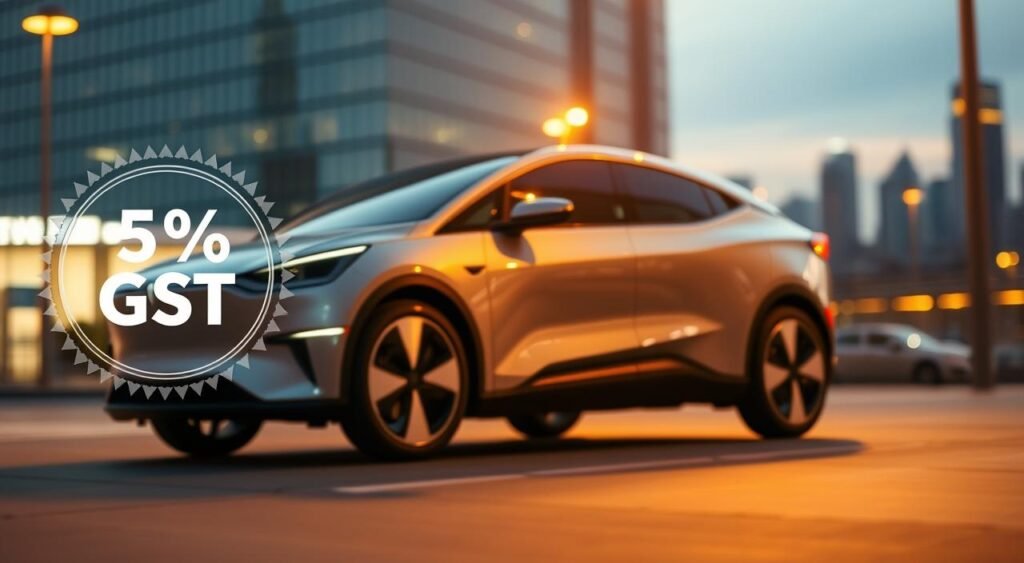
Impact of 5% GST on FCV Pricing
The lower GST rate saves a lot of money for buyers. For example, a fuel-cell car priced at Rs. 60 lakh gets a GST of just Rs. 3 lakh. This is much less than the taxes on regular luxury cars.
Comparisons with Other Vehicle Categories
| Vehicle Category | GST Rate | Additional Cess | Total Tax Impact |
|---|---|---|---|
| Fuel-Cell Vehicles | 5% | 0% | 5% |
| Electric Vehicles | 5% | 0% | 5% |
| Petrol/Diesel Cars | 28% | 1-20% | 29-48% |
| Hybrid Vehicles | 28% | 15% | 43% |
Fuel-cell vehicles now have the same tax benefits as electric vehicles. This makes them the most affordable eco-friendly cars to buy. They also get extra state incentives and lower fees in many places.
Five Fuel-Cell Vehicles Emerging in India
India’s car market is changing fast. Big names are getting ready to bring hydrogen cars to the roads. These cars use new tech that could change how we travel. Let’s look at the top FCVs that might get cheaper soon.
Toyota Mirai: A Trailblazer in FCVs
The Toyota Mirai is a leader in hydrogen cars worldwide. It’s a sleek sedan with over 180 PS power. It can go 600-650 kilometers on one tank, making long trips easy.
What’s cool about the Mirai is how fast it refuels. Just five minutes to fill up. It’s been improved over the years, making it even better.
Hyundai Nexo: An Innovative Approach
Hyundai’s Nexo is a mid-size SUV, like the Tucson. It goes over 700 kilometers on a single tank. It also refuels quickly, in just five minutes.
This SUV is great for families. It’s big and has the latest fuel-cell tech. It’s a top choice for those wanting a big, green car.
Honda Clarity: Features and Benefits
Honda’s CR-V FCEV is different. It has a hydrogen fuel cell and a 17.7 kWh battery. This combo gives it a 450-kilometer range.
It’s special because you can use electric power too. This makes it very versatile, unlike most FCVs.
Tata Motors’ Future Projections
While big brands lead, Tata Motors is also working on hydrogen cars. They see the value of fuel cells for India. They’re making cars that fit India’s needs and infrastructure.
How 5% GST Could Boost FCV Sales
The introduction of a 5% GST rate for fuel-cell cars in India is a big deal. It makes fuel-cell cars more affordable for both makers and buyers. This could change the game for clean energy vehicles in the market.
Potential for Increased Adoption Rates
The 5% GST rate lowers the cost of fuel-cell cars in India. This makes them more appealing to a wider range of people. Electric vehicles, on the other hand, face GST rates between 12% to 28%.
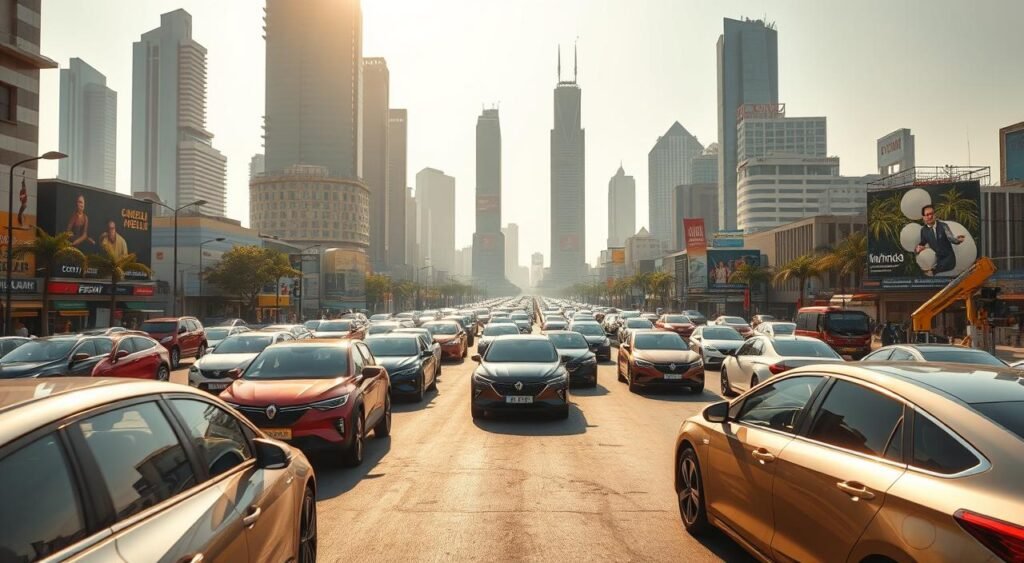
Lower taxes could lead to a 30-40% increase in FCV adoption in the first two years. Fleet operators and corporate buyers are interested in FCVs. They like the quick refueling and longer driving ranges compared to electric cars.
Encouragement for Manufacturers and Investors
The reduced GST rate shows India’s commitment to hydrogen technology. Big names like Toyota and Hyundai are thinking about bringing their hydrogen models to India. The tax benefits make it easier to produce and sell these cars locally, attracting more investment.
Consumer Awareness and Education
For FCVs to succeed, people need to understand their benefits. Zero tailpipe emissions, fast refueling, and long driving ranges are key. Industry groups and the government are working on campaigns to spread the word about these advantages and the 5% GST rate.
Environmental Impact of Fuel-Cell Vehicles
Fuel-cell vehicles are a big step forward in clean energy cars. They help India move towards a greener future. Unlike gas cars, FCVs only release water vapor, not harmful pollutants.
This is great news for India’s air quality and its environmental goals.
Reducing Carbon Emissions
Fuel-cell vehicles don’t have tailpipe emissions, making them eco-friendly cars. Each FCV can cut down about 4.6 metric tons of CO2 a year. This is a big deal for cities like Delhi and Mumbai, which are really struggling with air pollution.
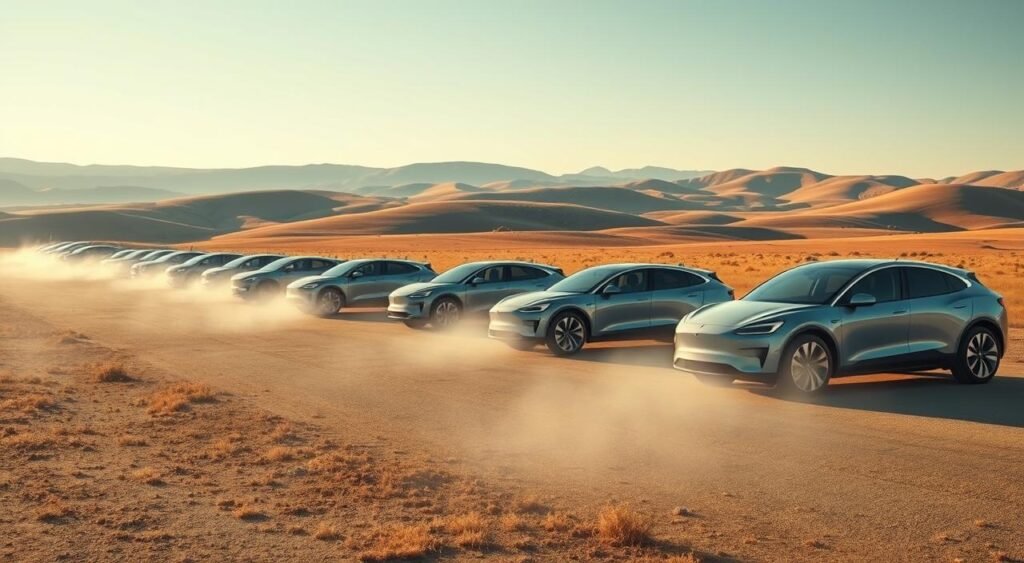
The Role of Renewable Energy in FCVs
The good news about green vehicles goes beyond zero emissions. If hydrogen is made from solar or wind power, FCVs are totally carbon-neutral. India’s growing solar farms in places like Rajasthan and Gujarat are perfect for making clean hydrogen.
Long-term Sustainability Benefits
FCVs have big advantages over electric cars in how they affect the environment. They don’t have the lithium mining and battery disposal issues. They also need fewer rare earth materials and last longer.
As India builds its hydrogen network, these clean energy cars will be key to reaching its 2070 net-zero emissions goal.
FCVs vs. Battery Electric Vehicles (BEVs)
The Indian car market is at a turning point. It’s between fuel-cell vehicles and battery electric vehicles. Each has its own benefits for those who care about the environment. Knowing the differences helps people choose the right car for them.
Comparing Performance and Efficiency
Fuel-cell vehicles are quick to refuel, taking only 3-5 minutes. This is much faster than charging electric cars, which can take hours. They also have a long range, up to 820 kilometers per tank, beating many electric cars.
Battery electric vehicles are better at using energy, turning 77% of it into power. Fuel-cell cars are about 60% efficient. Both types don’t emit any pollution, making them good choices for clean energy.
Cost Considerations and Long-term Value
There’s a big price difference at the start:
| Vehicle Type | Average Price Range (INR) | Fuel Cost per 100km | Maintenance Frequency |
|---|---|---|---|
| Fuel-Cell Vehicles | 50-65 lakhs | ₹400-500 | Every 10,000 km |
| Battery Electric Vehicles | 15-35 lakhs | ₹80-150 | Every 15,000 km |
BEVs are cheaper to run, which appeals to those watching their budget. Fuel-cell cars need less battery replacement, which could save money in the long run, even if they cost more upfront.
Infrastructure Needs for Both Technologies
Building more charging stations is key for both types. India had over 1 million EV charging points by 2019. But, hydrogen cars have fewer places to refuel.
Setting up hydrogen stations is expensive, costing ₹15-20 crores each. EV charging is easier to expand, with many people able to charge at home. Both need more stations to become more popular in India.
The Role of Government in Promoting FCVs
The government is key in shaping the future of fuel-cell cars in India. They are making policies and partnerships to help hydrogen cars grow. The 5% GST rate is a big step towards making cars more affordable and sustainable.
Incentives for Consumers and Businesses
The Indian car industry is getting a lot of support from the government. The 5% GST rate makes fuel-cell cars cheaper than regular cars. This can save people around ₹5-10 lakhs on high-end FCVs.
- Direct purchase subsidies under the FAME scheme
- Tax deductions for businesses adopting hydrogen fleets
- Reduced road tax and registration fees in select states
- Priority parking and toll exemptions for FCV owners
Collaborations with Automotive Manufacturers
Partnerships between the government and car makers are speeding up FCV development. The 2022 pilot program with Union Minister Nitin Gadkari testing the Toyota Mirai was a big moment. These partnerships include research and technology sharing with Toyota and Hyundai.
Future Policy Directions
The future plans include building more hydrogen stations and growing the market. They aim to have 100 stations by 2030 in big cities. The goal is to use green hydrogen made from renewable energy, making cars run on clean energy.
Policy frameworks are being drafted to standardize hydrogen fuel quality and safety protocols, creating a strong ecosystem for the industry’s future.
Public Perception and Acceptance of FCVs
In India, understanding hydrogen vehicles is a big challenge. Many people don’t know how FCVs work or their benefits. We need to clearly explain how they work and address concerns to gain trust.
Common Misconceptions About Fuel-Cell Technology
Many myths about FCVs slow their adoption. Some think they’re dangerous because of fuel storage. But, modern hydrogen tanks are tested and safe.
Another myth is that they can’t go far. The Toyota Mirai can go over 400 miles on one tank, just like gas cars. High costs are also a worry. But, running them is cheaper, and refueling is quick.
Japan and South Korea have shown FCVs are reliable. But, many in India don’t know this.
Educational Initiatives for Consumers
Car makers and governments are working to teach people about FCVs. They offer test drives and share info online. They also train dealers and service centers.
Success Stories from Early Adopters
The 2022 Toyota Mirai pilot in New Delhi was a success. Fleet operators were happy with the cars’ performance. Programs in California and Germany offer lessons for India.
Companies using hydrogen vehicles save money and help the environment. This encourages more people to accept them.
The Future of Fuel-Cell Cars in India
India is at a turning point with fuel-cell cars set to change its car scene. A 5% GST cut opens doors for eco-friendly cars to enter the market. Big names like Toyota and Hyundai are getting ready to launch their fuel-cell models. Tata Motors, a local company, is also diving into this exciting tech.
But, there’s a lot of work ahead. We need to plan well and invest in hydrogen infrastructure.
Predictions for Market Growth
Experts think fuel-cell cars in India will grow slowly but surely over the next ten years. The Toyota Mirai and Hyundai Nexo are set to be the first ones on the market. BMW’s iX5 Hydrogen and Honda’s CR-V FCEV are also waiting for the right time to come out.
They predict that by 2030, hydrogen cars could grab 2-3% of the premium car market. This will happen if we have more hydrogen stations and teach people about fuel-cell tech.
Technological Advances on the Horizon
New tech in fuel cells promises better efficiency and lower costs. Engineers are working on better hydrogen storage and using less platinum in fuel cells. The Toyota Crown shows off advanced fuel-cell tech that might come to India.
Improvements in battery tech are also helping fuel cells. They’re making hybrid systems that use both power sources. These changes make eco-friendly cars more suitable for Indian roads and driving habits.
Closing Thoughts on the Importance of FCVs in India
Fuel-cell vehicles are key for India’s clean transport future. The GST cut shows the government’s support for green vehicles, not just battery electric ones. Success needs teamwork between car makers, energy firms, and government to build hydrogen stations.
The path to making fuel-cell cars common in India is long. But, the steps we take today will shape tomorrow’s transport. As India seeks energy freedom and cleaner air, fuel-cell cars are a vital option that deserves our support.
FAQ
What is the new GST rate for fuel-cell vehicles in India?
The GST rate for fuel-cell vehicles in India has been cut to 5%. This change took effect on September 22, 2025. It makes FCVs more affordable, putting them in a better tax position than traditional vehicles.
How do hydrogen vehicles differ from battery electric vehicles?
Hydrogen vehicles use hydrogen as fuel and can refuel quickly, like regular cars. Battery electric vehicles take longer to charge. FCVs have long driving ranges and zero tailpipe emissions, making them eco-friendly and convenient.
Which fuel-cell cars could launch in the Indian automotive industry?
Five FCVs might soon hit the Indian market. These include the Toyota Mirai, Hyundai Nexo, Honda CR-V FCEV, BMW iX5 Hydrogen, and Toyota Crown. They offer various styles and power, from 180 PS to over 400 PS.
What are the main challenges facing clean energy cars adoption in India?
The biggest hurdle is the lack of hydrogen refueling stations. India has many EV charging points but few for hydrogen. Despite government support, building more stations is key for wider adoption.
What are the environmental benefits of green vehicles like FCVs?
FCVs emit no tailpipe emissions, making them better for the environment than traditional cars. They use hydrogen instead of lithium-ion batteries, reducing environmental impact. This supports India’s goal for cleaner energy and lower carbon emissions.
How does the 5% GST benefit compare to other eco-friendly cars?
The 5% GST rate makes FCVs cheaper for buyers. This tax advantage makes premium FCVs like the Toyota Mirai more competitive in India. It’s a big plus compared to cars with higher GST rates.
What role has the government played in promoting fuel-cell cars in India?
The government has backed FCVs with a 5% GST rate and pilot programs. The 2022 Toyota Mirai study shows their commitment. But, more work is needed to improve infrastructure.
How long does it take to refuel a hydrogen vehicle?
Refueling hydrogen vehicles takes just 3-5 minutes, similar to traditional cars. This is a big plus over battery electric vehicles, which take hours to charge. It makes FCVs great for long trips and quick stops.
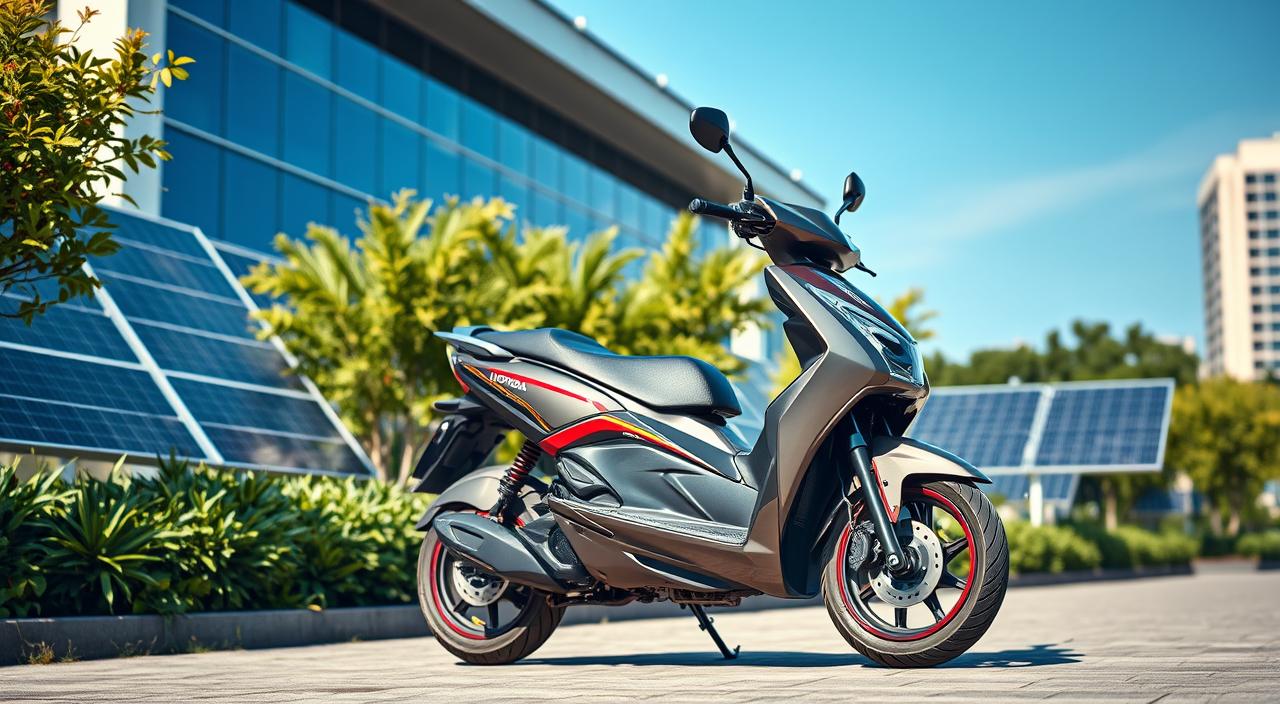
Nov
Honda is about to launch the Activa Electric on November 27, 2023. This electric scooter is set to change the Indian two-wheeler market. It offers eco-friendly mobility, combining innovation, performance, and affordability.
The demand for electric scooters is growing fast. Honda’s Activa Electric is a hope for those who care about the environment. It has a range of at least 100 km on one charge and uses swappable batteries.
The Activa Electric is more than just a scooter. It shows Honda’s dedication to electric mobility. It has a sleek design, room for two, LED headlights, and even a choice of instrument clusters.
This scooter is Honda’s first electric model for India. It aims to challenge big names like Ather, Bajaj, TVS, and Ola. Honda wants to make electric scooters affordable and accessible to more people.
Key Takeaways:
- Honda Activa Electric launches on November 27, 2023, with eco-friendly mobility solutions.
- The scooter has a range of at least 100 km and uses swappable batteries.
- It comes with LED headlights, spacious seating, and a choice of instrument clusters.
- Honda plans to challenge big names in the Indian electric scooter market with good prices.
- The Activa Electric shows Honda’s commitment to electric mobility.
Introduction to the Honda Activa Electric
The Honda Activa Electric is a big step towards sustainable travel and energy-efficient commuting. Cities face problems like congestion and pollution. Electric two-wheelers are seen as a good solution for urban commuting.
Honda, a well-known name in cars, is changing the electric scooter market with the Activa Electric. It offers zero-emission rides and doesn’t lose out on performance or convenience.
Overview of Electric Two-Wheelers
Electric two-wheelers are becoming more popular, thanks to better batteries and more people caring about the environment. They cost less to run, produce fewer emissions, and are quieter. Honda wants to make electric mobility easier and more appealing with the Activa Electric.
Importance of Sustainable Transportation
Sustainable transport is key to lessening the environmental harm of urban commuting. The Activa Electric fits with Honda’s goal to be carbon neutral by 2050. It aims to cut down daily travel’s carbon footprint and make city air cleaner.
| Feature | Details |
|---|---|
| Expected Price Range | Rs 1 lakh to Rs 1.30 lakh ex-showroom |
| Claimed Range | 104km in standard mode |
| Riding Modes | Standard, Sport, and reverse mode |
| Variants | Base model with a simple LCD console, top variant with a 7-inch TFT console |
| Potential Battery Setup | Dual 1.3kWh battery |
Key Features of the Honda Activa Electric
The Honda Activa Electric is a game-changer in electric two-wheelers. It combines style, performance, and sustainability perfectly. Its sculpted body panels and lightweight frame make it sleek and easy to handle in the city. The advanced dual TFT displays offer essential info and connectivity, making the ride better.
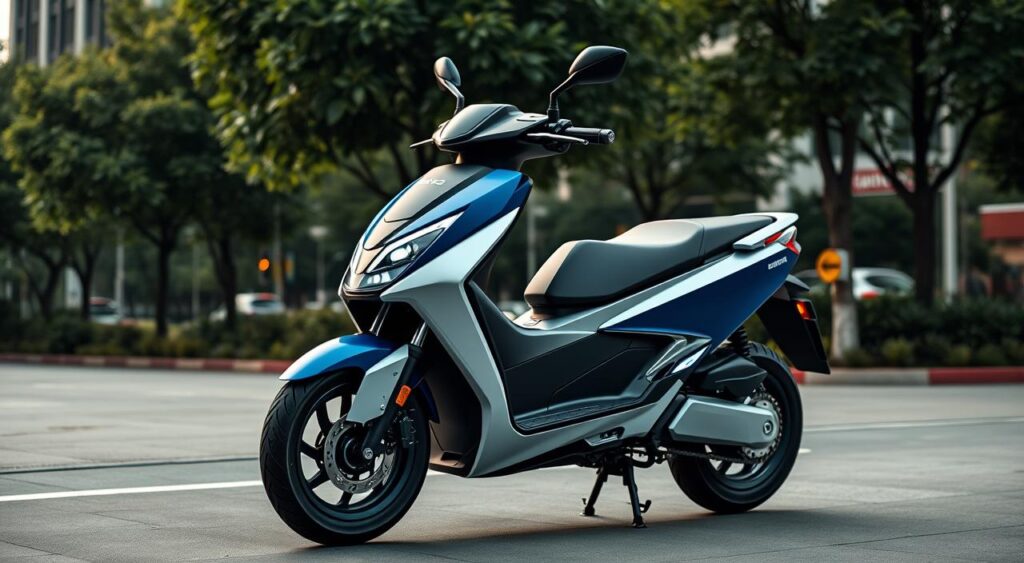
Design and Aesthetics
The Activa Electric has a modern design that looks great and works well. Its body panels are shaped for speed and style. The lightweight frame makes it agile and easy to control. Its premium finishes and details make it stand out on the road.
Technical Specifications
The Activa Electric runs on two swappable batteries from Honda. It can go 102 km on one charge. It has three riding modes – STANDARD, SPORT, and ECON – for different needs. It’s set to launch on November 27, 2023, and is expected to change the electric two-wheeler market in India.
| Feature | Specification |
|---|---|
| Battery Range | 102 km on a single charge |
| Riding Modes | STANDARD, SPORT, ECON |
| Batteries | Two Honda Mobile Power Pack e: swappable batteries |
Safety Features
Honda prioritizes safety, and the Activa Electric is no different. It has:
- Front disc brakes for better stopping
- Telescopic shockers for stability and comfort
- Anti-theft lock to keep it safe
These features, along with its handling and tech, make for a safe and fun ride.
Performance and Efficiency
The Honda Activa Electric is set to change the electric two-wheeler market. It offers great performance and efficiency. This eco-friendly scooter aims to make riding easy while being kind to the environment.
Battery Life and Range
The Activa Electric has a dual removable battery system. It can go 104 km on one charge, perfect for daily rides. You can swap out batteries at Honda’s stations to keep going.
Charging Times and Options
The Activa Electric also supports at-home charging. It comes with a special charging socket. This lets you charge at home, giving you freedom to ride without worry.
Real-World Performance Metrics
The Honda Activa Electric is a strong contender in the electric scooter market. Here’s how it stacks up against others:
| Model | Range (km) | Top Speed (kmph) | Power Output (bhp) | Price (ex-showroom) |
|---|---|---|---|---|
| Honda Activa Electric | 104 | 80 | 8 | ₹1,00,000 |
| Ola S1X | 91 | 90 | 8.5 | ₹83,000 |
| Bajaj Chetak | 95 | 70 | 4.08 | ₹1,10,000 |
| Vida V1 | 165 | 80 | 6 | ₹1,17,000 |
| TVS iQube | 75 | 78 | 4.4 | ₹1,17,000 |
The Honda Activa Electric is ready to make a big splash in the Indian electric scooter market. It launches in spring 2025 with impressive specs.
Riding Experience
The Honda Activa Electric offers a top-notch ride. It combines comfort, performance, and eco-friendliness. Its design and suspension make for a smooth ride for everyone.
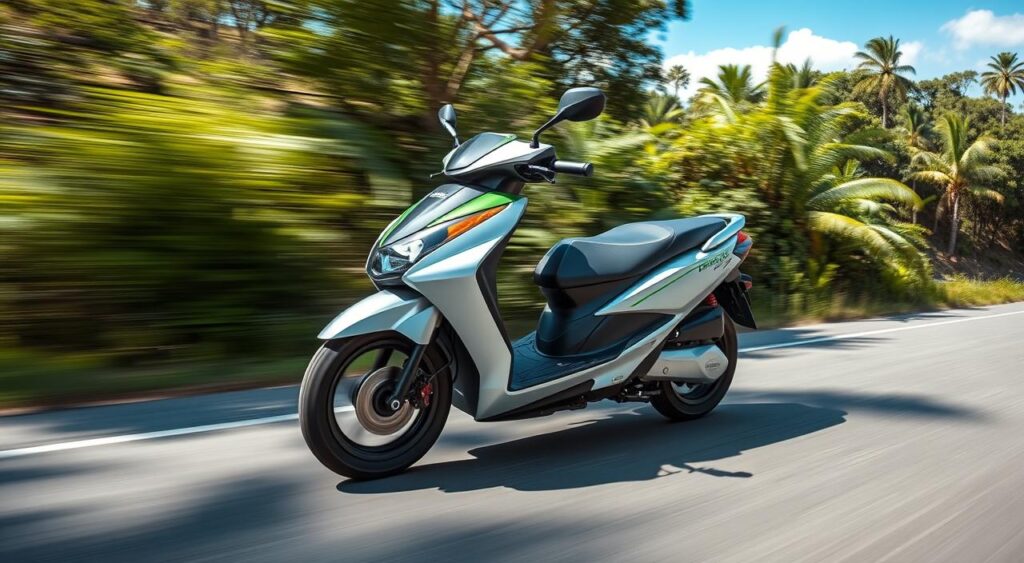
Comfort and Ergonomics
The Activa Electric focuses on rider comfort. It has a cushioned seat and plenty of foot space. The handlebar is set for a comfortable, upright riding position.
This scooter is light and easy to handle. It’s perfect for city streets.
Handling and Stability
The Activa Electric handles well thanks to its suspension. It has a front telescopic and rear mono-shock absorber. These absorb bumps, making the ride smooth.
The wide tires give great grip. This makes cornering and braking safe and confident.
The scooter’s electric motor provides instant torque. It accelerates smoothly, making it great for city traffic. Its urban maneuverability is unmatched.
Noise and Vibration Levels
The Activa Electric is very quiet. Its electric motor makes less noise than traditional scooters. This means a peaceful ride, even in busy cities.
There are no engine vibrations. This makes long rides more comfortable and less tiring.
| Feature | Activa Electric | Traditional Scooters |
|---|---|---|
| Noise Level | Minimal | High |
| Vibration | Low | Moderate to High |
| Acceleration | Smooth and Instant | Gradual |
Technology and Connectivity
The Honda Activa Electric brings new tech to two-wheelers. It has advanced features and connectivity options. This electric scooter keeps you connected and informed, making your rides better.
Smart Features and Apps
Pair your smartphone with the Honda Activa Electric using a dedicated app. This app gives you access to lots of useful info and features. You can see:
- Real-time battery status and range
- Trip history and statistics
- Navigation assistance with turn-by-turn directions
- Remote diagnostics and service reminders
Instrument Cluster Innovations
The digital instrument cluster on the Honda Activa Electric is amazing. It shows all the important info you need quickly. You can see:
- Speed and odometer readings
- Battery level and estimated range
- Riding mode selection (Standard, Sport, or Econ)
- Smartphone connectivity status
The design is easy to read, even in bright light. It keeps you informed and in control.
Integration with Other Devices
The Honda Activa Electric also connects with other devices and services. You can:
- Sync your ride data with fitness apps to track your activity levels
- Use voice assistants like Siri or Google Assistant for hands-free control
- Receive notifications from your favorite apps on the instrument cluster display
With these tech features, the Honda Activa Electric keeps you connected and entertained. It’s perfect for tech-savvy riders who value smartphone connectivity, navigation assistance, and remote diagnostics.
Environmental Impact
The Honda Activa Electric is at the forefront of making urban transport greener. It helps riders cut down their carbon footprint. This makes the environment cleaner and more sustainable.
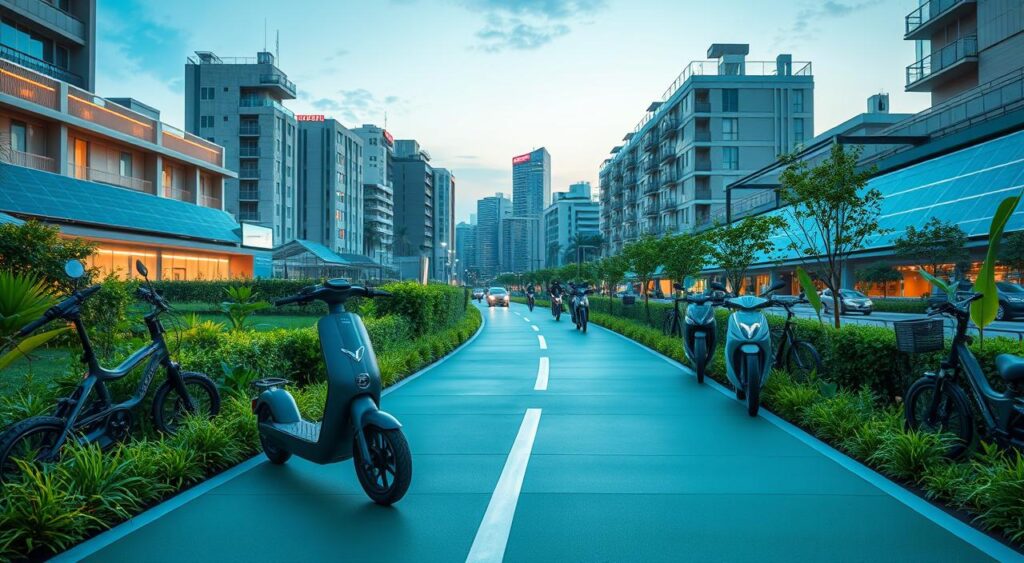
Reducing Carbon Footprint
The Activa Electric has zero emissions. This is a big difference from traditional scooters that pollute. Every ride on this scooter reduces carbon emissions in cities.
Contribution to Urban Mobility
Cities are getting bigger, and we need better transport solutions. The Honda Activa Electric is a key player in this change. It’s a green option that cuts down air pollution and fossil fuel use.
Comparison with Traditional Scooters
Looking at the Activa Electric and traditional scooters, the green benefits are clear. Here’s a quick comparison:
| Feature | Honda Activa Electric | Traditional Petrol Scooter |
|---|---|---|
| Emissions | Zero tailpipe emissions | Emits harmful pollutants |
| Fuel Source | Clean, renewable electricity | Fossil fuels (petrol) |
| Noise Pollution | Quiet, virtually silent operation | Contributes to noise pollution |
| Environmental Impact | Minimal, promotes sustainability | Significant, contributes to air pollution |
Choosing the Honda Activa Electric over a traditional scooter is a smart choice. It shows a commitment to a greener future for city travel.
Market Position and Competitors
The Honda Activa Electric is ready to shake up the electric scooter market. It combines Honda’s well-known brand with the latest tech and competitive pricing. It’s expected to start at ₹80,000 and go up to ₹1.15 lakh (ex-showroom).
Comparisons with Other Electric Scooters
The Activa Electric will face off against big names like the Ola S1, Bajaj Chetak EV, Vida V1, and Ather 450. It’s expected to go over 100 km on a single charge, beating the Honda CUV-e’s 72 km range. It will also hit speeds of about 80 kmph, making it a mix of efficiency, performance, and cost-effectiveness.
Pricing Strategy
Honda’s competitive pricing for the Activa Electric aims to draw in many customers. It’s for those who care about the environment, city commuters, and tech lovers looking for easy, green rides. Honda wants to grab a big piece of the electric scooter market by being affordable.
Consumer Demographics
The target audience for the Honda Activa Electric is varied. It includes young professionals and eco-friendly families. Its modern design, advanced features, and good price make it appealing to those who value style, ease, and green living in their daily travel.
Customer Feedback and Reviews
As the Honda Activa Electric scooter gets ready to hit the roads, early users and experts are sharing their first thoughts. Their feedback and ratings will help shape the scooter’s image and guide future buyers.
Owner Testimonials
Excited owners are sharing their love for the Activa Electric on social media. Anita Patel, a Mumbai commuter, says, “I’ve been riding my Activa Electric for a week, and it’s amazing. It’s smooth, quiet, and good for the planet.”
Vikram Singh, an environmental activist from Delhi, also praises the scooter. “The Activa Electric has been a big hit. Its battery lasts long, and I can easily get to work without needing to charge. Honda has done a great job.”
Expert Reviews
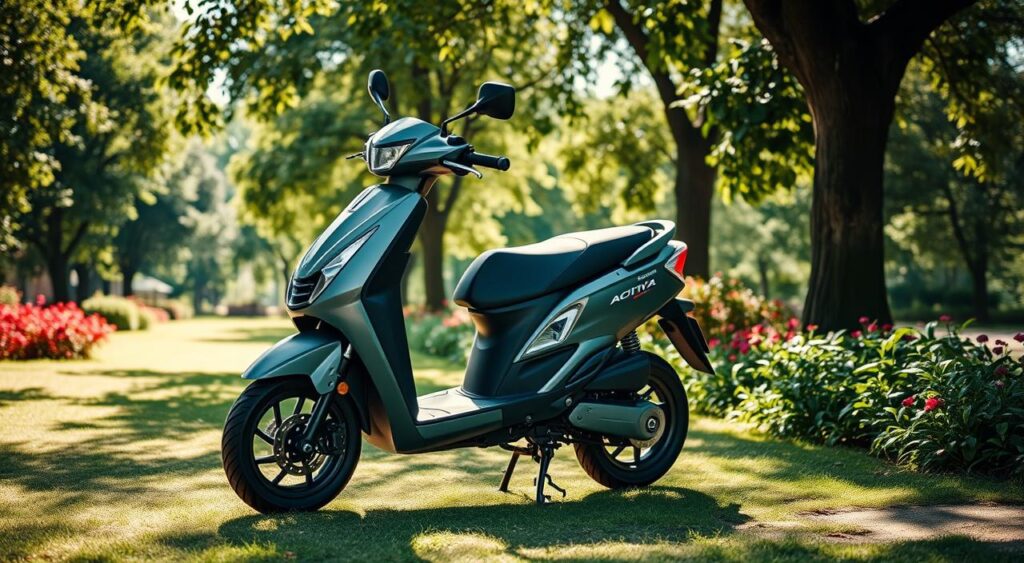
Automotive journalists and experts have tested the Activa Electric thoroughly. Rahul Sharma, a well-known blogger, says, “The Activa Electric is a game-changer. Honda’s focus on quality and detail is clear. It’s stylish, performs well, and is eco-friendly.”
Priya Gupta, a tech reviewer, highlights the scooter’s smart features. “The Activa Electric stands out with its tech. The app gives insights into battery health and more, making it a modern scooter.”
Common Praise and Complaints
As more people try the Activa Electric, common themes in feedback start to show. Many love the scooter’s:
- Sleek design and comfy ride
- Great range and battery life
- Easy controls and interface
But, some common complaints include:
- Not enough color choices at launch
- It costs more than traditional scooters
- Fast-charging spots are scarce in some places
Despite these issues, the overall feeling about the Activa Electric is positive. Many customers are happy with Honda’s move into electric scooters.
Maintenance and Support
Electric scooters need low maintenance costs and reliable support. The Honda Activa Electric focuses on these needs. It has a well-thought-out maintenance and support system.
The Activa Electric is designed to need less maintenance. Its electric powertrain has fewer parts than traditional scooters. This means less need for oil changes and engine tune-ups.
Warranty and Service Packages
Honda aims to give customers peace of mind. They will offer warranty and service packages for the Activa Electric. These packages might include:
- Extended warranty coverage for the battery, motor, and controller
- Free periodic maintenance check-ups
- 24/7 roadside assistance
- Discounted rates on spare parts and accessories
Authorized Service Centers
Honda has many authorized service centers in India. They will help with repairs and maintenance for the Activa Electric. These centers have skilled technicians and genuine spare parts.
Availability of Spare Parts
Having spare parts available is key for vehicle maintenance. Honda plans to keep a strong supply chain for Activa Electric parts. This will help customers get replacements quickly, keeping their scooters running well.
| Component | Warranty Coverage |
|---|---|
| Battery | 3 years or 30,000 km |
| Motor | 3 years or 30,000 km |
| Controller | 3 years or 30,000 km |
| Charger | 1 year |
Honda wants to make sure Activa Electric owners have a smooth ride. They focus on maintenance and support. This makes the Activa Electric an appealing choice for many.
Government Policies and Incentives
The Indian government is pushing for more electric vehicles, like the Honda Activa Electric scooter. They want to cut down on pollution, improve air quality, and support green transport.
Subsidies for Electric Vehicles
The FAME II scheme gives big subsidies for electric two-wheelers. This makes them cheaper for people to buy. The Honda Activa Electric and other scooters with big batteries get these subsidies.
The Hero Electric Splendor, for example, goes up to 120 km on one charge. It’s eligible for big incentives under FAME II.
State and Federal Initiatives
States also offer their own perks for electric vehicles. These include tax breaks and lower fees for registration. These deals make electric scooters like the Honda Activa Electric even more appealing.
Some states don’t charge road tax or fees for electric cars. Others give extra money on top of what FAME II offers.
The government is also working on more charging spots. The Ministry of Power has rules for setting up these stations. Hero Electric has a big network of charging spots and battery swaps to help.
| Scooter Model | Range (km) | Top Speed (km/h) | Instrument Cluster |
|---|---|---|---|
| Hero Electric Splendor | 120 | 45 | Digital |
| TVS iQube | 100 | 78 | TFT, customizable |
Impact on Consumer Adoption
Subsidies, tax breaks, and more charging spots have really helped electric scooters in India. They’re now cheaper to buy and run. This makes them a great choice for those who care about the planet and their wallet.
Models like the TVS iQube offer great range and style. They’re perfect for both new and seasoned riders. Dealerships also offer easy payment plans to make buying even more accessible.
As more people choose electric scooters, the market is growing fast. The Honda Activa Electric is set to play a big role in this green shift.
Future of the Honda Activa Electric
The Honda Activa Electric is set to change the electric scooter market in India and worldwide. It will launch on November 27, 2023. This scooter marks a new era in green transportation.
This scooter has a special dual battery system for easy swaps and longer rides. The first battery stations will be in Bengaluru, with plans to grow to more cities. It also charges at home or on the go, making it easy for riders.
Upcoming Updates and Features
Honda is always improving the Activa Electric. Future updates might include better batteries, longer ranges, and new smart features. It already has three riding modes for different needs, making it efficient and fun to ride.
| Model | Cruising Range | Driving Modes |
|---|---|---|
| ACTIVA e: | 102 km | STANDARD, SPORT, ECON |
| QC1 | 80 km | – |
Expansion into New Markets
Honda plans to launch 30 electric models worldwide by 2030. The ACTIVA e: and QC1 are the 12th and 13th models. They’re focusing on India, where electric scooters are in high demand.
DIY electric scooter conversions are popular in India, costing around ₹1 lakh. They offer a range of 120 km, showing the growing interest in electric scooters.
Long-term Vision for Electric Mobility
Honda’s vision for electric vehicles goes beyond the Activa Electric. They aim to be carbon neutral by 2050. They plan to make all motorcycle products carbon neutral by the 2040s.
Honda will make the Activa Electric and other models in India. This meets the growing demand for electric vehicles in the country.
Honda is also working on the Honda e:Swap battery sharing service in India. This service aims to make electric vehicles more accessible. With the Activa Electric leading the way, Honda is pushing towards a greener future.
Conclusion: The Future is Electric
Looking ahead, electric vehicles are the clear choice for transportation. The Honda Activa Electric is a prime example, combining eco-friendliness, cost-effectiveness, and easy travel. It’s set to change how we ride on two wheels with its cutting-edge features and Honda’s quality.
Summary of Benefits
The Honda Activa Electric offers many perks for those who care about the environment. It cuts down on carbon emissions, helping our cities breathe easier. Plus, it saves money over time compared to gas-powered scooters.
Charging at home is easy, and it needs little upkeep. This makes it a simple, worry-free way to get around.
Call to Action for Future Buyers
With the Honda Activa Electric on the horizon, I urge you to think about going electric. It’s not just a scooter; it’s a step towards a cleaner world. Join the electric movement and enjoy the benefits of green, affordable, and easy travel.
Visit your local Honda dealer to find out more. Take a ride and see the future of two-wheeled travel for yourself.
FAQ
When will the Honda Activa Electric be launched?
The Honda Activa Electric is set to launch on November 27, 2023. This marks Honda’s entry into the electric scooter market.
What is the range of the Honda Activa Electric?
The exact range of the Honda Activa Electric has not been officially announced yet. It is expected to offer a competitive range for urban commuting and daily travel needs.
Does the Honda Activa Electric have a swappable battery system?
Yes, the Honda Activa Electric has a dual removable battery system. This allows riders to swap depleted batteries for fully charged ones at designated stations. It enhances convenience and reduces downtime.
Can the Honda Activa Electric be charged at home?
Yes, the Honda Activa Electric supports at-home charging. It comes with a compact, dust- and water-protected charging socket. Users can charge the scooter conveniently using a standard electrical outlet.
What are the different riding modes available on the Honda Activa Electric?
The Honda Activa Electric offers three distinct riding modes. These modes allow riders to optimize performance, efficiency, and battery consumption based on their specific requirements and riding conditions.
Does the Honda Activa Electric have smartphone connectivity?
Yes, the Honda Activa Electric comes equipped with advanced technology features. It includes smartphone connectivity via a dedicated app. Riders can access real-time information, navigate, and monitor the scooter’s performance remotely using their smartphones.
How does the Honda Activa Electric contribute to reducing the carbon footprint?
The Honda Activa Electric is a zero-emission vehicle, producing no tailpipe emissions. By opting for an electric scooter like the Activa Electric, riders can significantly reduce their carbon footprint. This contributes to cleaner urban environments, combating air pollution and promoting sustainable mobility solutions.
What kind of warranty and service packages can be expected with the Honda Activa Electric?
Honda is known for its extensive warranty and service packages. While the specific details for the Activa Electric have not been announced yet, it is expected that Honda will offer competitive warranty terms. They will also provide reliable after-sales support to ensure customer satisfaction and peace of mind.
Are there any government incentives available for purchasing the Honda Activa Electric?
Yes, government policies and incentives play a key role in promoting the adoption of electric vehicles. Schemes like FAME II offer subsidies and tax benefits. These incentives make electric scooters like the Activa Electric more affordable for consumers.
What future updates and features can be expected for the Honda Activa Electric?
Honda’s long-term vision for electric mobility involves continuous innovation and improvement. Future updates for the Activa Electric may include enhanced battery technology, extended range, and additional smart features. Honda aims to stay at the forefront of the electric scooter market by providing cutting-edge technology and user-centric improvements.
